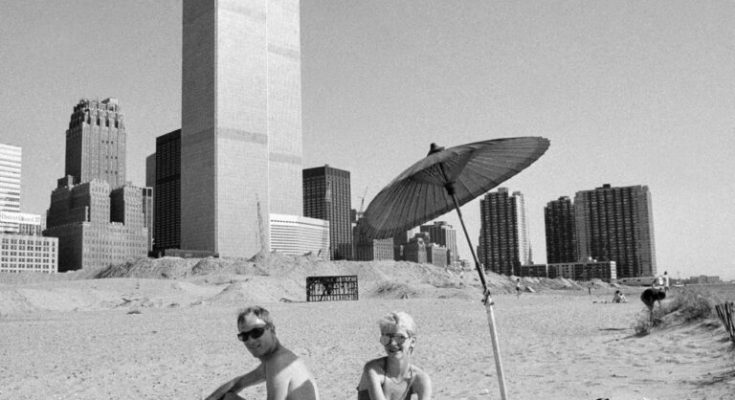A few moments ago, a spectacular picture of the Twin Towers in Manhattan with a gorgeous beach in the foreground appeared on my phone’s screen.
As though they were in a tropical paradise, people were relaxing in the sand. Could this be genuine, though?
The neglected beach haven in New York City
It’s almost hard to comprehend that there used to be a beach along the shoreline if you walk along the seas close to Battery Park, where the Twin Towers used to be.
The neighborhood is now dotted with modern structures and busy streets, and the sound of the city permeates the atmosphere. The Statue of Liberty can be seen in the distance as the sea gently laps against a contemporary promenade.
In actuality, though, people used to sunbathe here, enjoying the warmth of the sun and the World Trade Center’s shadows. Manhattan’s harbor welcomed people looking for a unique moment of peace and quiet, and the city’s hustle and bustle looked worlds away from this neglected seaside haven with its own sandy beachfront.
However, this sandy retreat was an unplanned oasis created by the World Trade Center’s construction delays in the middle of the 1970s.
Not intended for public use
In order to create a temporary beach along the waterfront, workmen dug up soil from the neighboring basin as the Twin Towers’ huge foundation took shape.
Manhattanites swiftly adopted it as their own, transforming it into an unexpected refuge even though it wasn’t intended for public usage. Under the looming shadow of the World Trade Center, readers found their quiet place by the sea, volleyball matches broke out in the sand, and sunbathers relaxed in the warm light of the sun.
Battery Park Beach is the name given to the stretch of sand that was formerly a building site and turned into a hidden beauty.
Amazingly, some people, like Suellen Epstein, can still recall what it was like to take a bath on that beach. She is shown in the photo below, enjoying the summer sun in 1977 while growing up in the adjacent Tribeca area.
Suellen talked about her beach recollections in an interview with Tribeca Citizen, pointing out that the sand wasn’t really the fine, soft kind you’d find on a tropical shore. Naturally, the ocean waves never kissed the somewhat coarse sand.
Hey, though, it worked.
Suellen told Tribeca Citizen, “We didn’t have the resources to go out to the Hamptons,” but she added, “We were out there on the beach any sunny Sunday – as long as it wasn’t wet.” It was an excellent location to spend the entire Sunday.
Suellen and her partner had a rare moment of alone time in the picture above. The beach was entirely theirs on the day the Times photo was taken.
“You had the impression that you were in the countryside of Manhattan rather than the city,” Suellen recalled.
Organizing the biggest anti-nuclear demonstration ever
In addition to providing a tranquil haven, the “acres and acres of landfill” that were finally turned into the beach also served as a potent platform for social change. A famous black-and-white image from September 23, 1979, shows a sandy no-man’s-land turned into the center of a sizable anti-nuclear demonstration.
As 200,000 people gathered at the tip of Manhattan for what would turn out to be the biggest anti-nuclear, pro-solar rally in history, hundreds of people sat in the sand, enjoying the sunny sky, free music, and a wave of controversy.
The beach was crowded with celebrities who were speaking out for the cause, so it wasn’t only the crowd that made the day memorable. Jane Fonda gave a moving address, and artists like Pete Seeger and Jackson Browne performed.
The national protest movement, which had mostly waned following the conclusion of the Vietnam War in 1975, was revived by the demonstration.
Nuclear power was now the cause, and the Harrisburg nuclear accident earlier that year served as the impetus for this fresh vigor.
Impressive installations
Tribeca Beach, also known as Battery Park Beach, was a vibrant creative venue that was teeming with artistic activity and entertainment. Artists could really afford to live and work in the city, and many tiny dance groups were flourishing. At that time, a grant was awarded to the public arts group Creative Time to bring art to the beach, which included a visually arresting installation by Mary Miss, a local environmental artist.
When the beach was used as the backdrop for Art on the Beach in 1980, young sculptor Nancy Rubins had a rare chance to leave her mark on this iconic site. She was amazed by the site’s enormous size and the engineering that went into it, even at the age of 27. She provided a piece made from discarded objects that she gathered in large quantities from several Goodwills, including lampshades, hoses, and small appliances.
In the end, her artwork grew into a rubbish tornado 45 feet high.
It was incredibly humble to work there. When I was young, it was really big,” she said to The New York Times.
An enormous wheat field
Agnes Denes’s Heatfield – A Confrontation was another eye-catching installation on the property. The two acres of wheat she planted, facing the Statue of Liberty and only a few blocks from Wall Street and the World Trade Center, was a startling reflection on the contemporary towers.
Denes worked 16 hours a day to make it all work, and she and her colleagues planted the wheat for a month. The article’s goal was to raise awareness of the pressing environmental issues in the nation’s financial hub.
A potent paradox was produced when a wheat field was planted and harvested on $4.5 billion worth of property. Wheatfield was a worldwide idea and symbol that stood for energy, food, business, international trade, and economics. Mismanagement, waste, world hunger, and ecological issues were mentioned, according to Denes’ website description of the project.
Don’t you believe the pictures of this project are nearly as breathtaking as the beach itself?
The real story behind the beach photo in Manhattan
I was initially drawn to this story because of the same creative spirit that led Chris Galori and David Vanden-Eynden to the beach. They are the ones in the picture below, which was captured by Fred Conrad, a former New York Times photographer. The image was taken in 1977.
In a 2019 interview with The New York Times, environmental graphic designer David recalled the setting, saying, “There were spectacular views of the towers and across the river, and there was nothing there yet.” He also disclosed that while not all of the waste was limited, some sections were cordoned off from the general public.
I was initially drawn to this tale because of the creative spirit that led David Vanden-Eynden and Chris Galori to the beach; they are the ones in the picture below, which was captured by Fred Conrad, a former New York Times photographer.
The image was taken in 1977.
During a 2019 interview with The New York Times, environmental graphic artist David recounted the scene:
“There were breathtaking views of the towers and across the river, but nothing was there yet.” He also disclosed that not all of the waste was limited, even though some sections were cordoned off from the general public.
The unsettling reality of the images
What became of this nearly unreal place, then?
The New York Times claims that when around 3,000 individuals moved to Battery Park City in 1983, things started to change. Today, the area feels more like a suburban office park than a real city neighborhood.
Almost all of the old landfill has been developed by 2000.
However, something that happened in 2001 gives these pictures a completely different perspective. The images of those sun worshippers peacefully relaxing make it difficult to avoid thinking about what occurred to the Twin Towers on that tragic September day.
We already know what they were unable to have: the World Trade Center’s terrible demise, which would permanently alter New York City’s environment.
These images now have an elegiac and eerie feel to them. After considering the pictures, one user wrote, “My God! Life, death, youth, aging, calm, and expectation are all depicted in this image.
The weight of that sentiment is difficult to ignore. The carnage that would transpire years later was unimaginable to these joyful sun worshippers.
“So much could be said,” said another.”But I’ll just stare and weep.”
We are also reminded of the unsettling reality as we gaze at these now-iconic pictures: everything changes as time passes, frequently in unexpected ways.
Was this story enjoyable to you? Please feel free to share it with your friends, ideally by using the Facebook share button.



